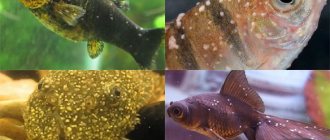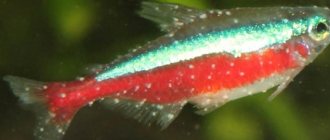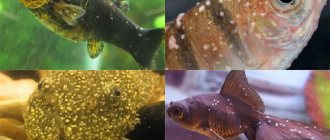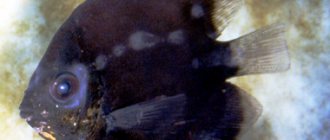Semolina or ichthyophthyriosis is a specific fish disease that has an infectious nature and is caused by ciliates. The main manifestation is the appearance of bumpy spots on the body similar to semolina. Treatment of semolina should begin as early as possible, since ichthik (another name for the disease) depletes the fish’s body every day, as a result of which it dies. Ichthyophthiriasis can occur in any species, so treatment in a community aquarium is recommended. In the aquarium industry, it has been verified that a fish can become infected with semolina once in its life.
Alkalosis
This disease occurs in some species of fish that move from an acidic environment to alkaline conditions with a pH of 7.3 to 8.0. Other causes of the disease:
- Excessive lighting in the aquarium.
- Too much vegetation.
To notice alkalosis, you need to take a closer look at the fish. They show the following symptoms:
- The scales become pale.
- Movements are jerky.
- Mucus on gills.
- The fins are spread out.
Fish with this pathology gradually go blind, and they die quite quickly.
If a white coating has formed on goldfish or other species, you need to transfer them to water with high acidity.
What to do
The fight against the disease starts with improving aeration. As well as removing activated carbon from the filter, if it is there. Raising the water temperature will be helpful. Because it will speed up the life cycle of the pest and, therefore, bring victory over it closer.
Treatment is carried out with specialized drugs, the action of which is directed specifically against ichthyophthyriosis. Their effect is reduced to disrupting the vital activity of parasites and suppressing the development of secondary infections.
Veterinary services for your pets can be viewed here Animal sales company
It is important to be careful with the choice and dosage of the drug. Study the instructions carefully. The duration of the course depends on the medication and the stage of the disease - up to 8 days.
After completion of treatment, you should filter the water with activated carbon or replace up to 60% of its volume. To speed up the healing of wounds left by the pest, it is recommended to use an anti-stress agent.
Dermatomycosis
This is a fungal disease in fish. Individuals with weakened immune defenses are susceptible to it. Fungi of various types can settle on fish.
The disease appears if the fish are in water with a low temperature for a long time. The situation is aggravated by the incorrect composition of the feed, increased acidity and a large amount of organic matter.
The first stage can be detected when the fish in the aquarium are covered with a white coating that resembles moss. If white threads appear on an individual, then ulcers and microtraumas should soon be expected. Gradually, the coating becomes like cotton wool; it covers the body and fins.
How to prevent the disease
Treatment of ringworm
Before starting treatment, prepare a septic tank. In this case, the drug “Bicillin” is used. This is an effective remedy for the treatment and prevention of infectious fish diseases. For 50 liters of water, 250,000 units of the composition are required. A diluted drug is added to the water. The procedure is performed within 4-6 days. The temperature in the container at this time should be at 26 degrees.
All items in the aquarium and plants are treated with antifungal compounds.
Treatment of fin rot in a community aquarium
If the disease is detected at an early stage, getting rid of it is quite simple. The first step is to set your aquarium heater to a higher setting (most bacteria do not grow in warm water). Regular replacements (about 30% of the total volume) will also be effective.
For several days, you should adhere to these conditions and monitor the affected pets. If no improvement occurs and fin rot continues to progress, then more drastic methods must be taken.
Gyrodactylosis
In this case, a white coating is visible on the fish in the aquarium. The tint may also be bluish. The fish stop moving and rub against various objects in the aquarium. Gradually, their fins separate, and ulcers appear on the body. Individuals die from lack of oxygen.
Copper sulfate is used to treat the disease. For 10 liters of liquid you will need 14-15 grams. The prepared medicine is poured into the depositor. It will take 6-7 days to overcome the disease. To prevent infection of other fish, the aquarium is treated with table salt.
Causes
The pathogen colonizes an aquarium with new fish, but the disease occurs only under unfavorable circumstances. For example, dirty, cold water weakens the fish, making it defenseless against the pathogen. The ciliate feeds on the body of the fish for about a week, then leaves it, sinks to the bottom, and multiplies. The new parasites can swim and find new victims.
Ichthyophthiriasis
Overheating does not help. The tropical variety of the parasite can remain in suspended animation for a long time; it feels good at 32°C. The ciliate spends its entire life cycle on fish, so treatment methods that work on local species of ciliates may be ineffective.
Trichodinosis
The disease is caused by ciliates. At an early stage, the disease is not noticeable. It can be assumed by the accumulation of sick individuals near the aerator.
If you notice a white coating on your goldfish in the aquarium, which later begins to separate in flakes, then the disease has entered the next stage. Mucus is noticeable on the gills, and breathing becomes difficult for individuals. The fish lose their appetite, they stop moving, and begin to itch against objects and the bottom of the aquarium. Some species can sway from side to side.
Trichodiniasis occurs due to untreated water, untreated decorative items and poor quality feed. The ciliates die immediately as soon as the fish are removed from the aquarium. Strong and healthy individuals are not afraid of the disease, even if the pathogen gets into the aquarium. If the fish organisms are already weakened, the pathogen begins active reproduction. Trichodins themselves are not very tenacious; they can live no more than two days without fish. Therefore, it is important to establish the cause of the spread of morbidity and eliminate unfavorable factors in a timely manner.
Symptoms and differential diagnosis
White spots form on the skin. These are skin formations of fish, inside which colonies of parasites are located. The fish becomes irritable, eats poorly, itches on the bottom and fragments of scenery, and tightens its fins. In the absence of effective control measures, the number of specks resembling grains of semolina increases, secondary microflora joins and the fish dies. In neglected situations, the entire aquarium dies out.
The aquarist must learn to make a diagnosis on his own. To do this, he should study pictures with photos of fish with various diseases. This is also necessary because treatments for diseases with similar symptoms may differ. White spot disease should not be confused with oodinosis or velveteen disease. Oodinosis is caused by another type of unicellular, the spots are very small, grayish-golden in color, the appetite remains.
Treatment of trichodinosis
To rid fish of this disease, the easiest way is to add one of the special preparations to the water:
- "Protocide."
- NILPA "Aquaform".
- "Kostapur".
- "ContraIk."
Each of them contains malachite green. You can also purchase malachite green at a chemical supply store. For treatment, a solution concentration of 0.05-0.07 mg/l should be prepared. Trichodins “do not like” malachite green, so this substance is highly effective. According to reviews from aquarium owners, the medicine is added over five days: first 2 ml, the next day 3 ml, then 4 ml and 10 ml. If you purchased a ready-made drug, you should follow the instructions for it.
Another effective remedy is FMC. It is also used according to the attached instructions. Fish owners say that the drug helps in 100% of cases to defeat an unpleasant disease.
Baths with table salt are also effective. You should take a 1.5-2% salt solution. Bathing in such baths is carried out for 10-15 minutes. Instead of salt, you can use potassium permanganate. To do this, take 0.5 grams of potassium permanganate per 10 liters of water, and place the fish in such a bath for 10-15 minutes every 12 hours.
In addition, aeration in the aquarium should be increased and the water should be heated to 30 degrees.
“White moss” is a symptom of saprolegniosis
This disease develops under unfavorable conditions: low temperature water and its high acidity. The development of the saprolegnia fungus is also accompanied by leftover food and fish injuries. It is in injured areas that the fungus hastens to settle. An area of skin or fin is populated with “white moss”, in which, upon careful examination, thin threads can be seen. They lengthen, intertwine, gathering into a lump. Later, new areas of the body are invaded and internal organs become infected.
How to treat if the fish has caught saprolegniosis? The infected individual should be placed in a separate container (jar) using water from an inhabited aquarium. Bicillin-5 is used to destroy the fungus. It is diluted in water at the rate of 500 thousand units per 100 liters. Recovery is practiced for 5-6 days. Keep the temperature elevated (up to 25-26 degrees).
Treatment with bicillin, diluted in the specified ratio, is also carried out for aquarium plants, stones, and decorations. An important point: the drug is effective only in a darkened room.
Costiosis
The pathology is caused by a flagellate. After the parasites land on the fish, they penetrate the skin cells and begin active reproduction. The most comfortable environment for them is water with a temperature of 26-28 degrees. However, when the indicator increases to 31 degrees, the death of parasites begins. Upon contact with the pathogen, individuals stop consuming food and moving. A white coating appears on the fish in the aquarium. The gills become covered with mucus and breathing becomes difficult. Fish can die quickly, especially when it comes to young fish. Adults do not die, but become carriers of a dangerous pathology.
Sources of parasites are:
- Infected fish.
- Parasites in the soil.
- Low quality food.
What to do if a white coating appears on the fish in the aquarium? Treatment should be started as soon as possible.
Symptoms of the disease
If you notice one of the following signs in your pets, you urgently need to start treatment:
- The fins, closer to the edge, lose color, become lighter, and become cloudy. This is the initial symptom of fin rot. Over time, the border grows and affects the entire fin. It is impossible not to notice the cloudiness of the fins of young animals, since they are mostly still transparent;
- Erosion grows intensively over the entire surface of the fins, provoking their disintegration;
- In young animals, the caudal and pectoral fins are primarily affected. In adults, damage occurs chaotically. In any case, rot begins at the edges and gradually reaches the base;
- Before the fin begins to disintegrate and rot, red spots and streaks may be visible on its surface. The reason for this is blockage of blood vessels;
- The eyes of some fish are also affected by this disease. The surface of the cornea becomes cloudy and acquires a whitish tint;
- Another symptom of fin rot is inflamed fin edges. They split and shorten in length over time. In fry, the fins simply dissolve;
- The damaged edges of the fins are white because ulcers with purulent fluid appear at the ends. Over time, the sores move to the beginning of the tail, and from there to the body. If the pet is not given timely help, the infection affects the entire body, and it dies.
Fin rot can be a secondary infection that is accompanied by completely different symptoms.
Ways to fight the disease
Methylene blue is used for treatment. This is a synthetic dye. You need to take or prepare a 1% solution (1 gram of substance per liter of water), dissolve 3 ml of the drug in 10 liters of water. Individuals must remain in such a liquid until complete recovery.
The temperature in the aquarium is gradually raised to 30-34 degrees, this helps get rid of parasites.
You will also need quarantine containers. They are filled with water to which a solution of potassium permanganate has been added. For 10 liters of liquid take 0.1 grams of the mixture. Each infected individual should be bathed in this solution.
You can use a solution of table salt. But in this case, care should be taken, since prolonged exposure to salt water can lead to the death of fish. Salt baths should be very short-lived.
To prevent pathology, all newly purchased fish should be kept in a quarantine tank for a month. After this, they should be put through a preventive salt bath at least three times, only after which they can be placed in a common aquarium. Under no circumstances should you allow water that contained live food, as well as water from natural sources, to enter the aquarium.
Immunity
Often fish get sick with semolina only once. Subsequently, they develop immunity to this disease. Therefore, if a carrier fish appears in the aquarium, then the recovered fish will either not react to the bacteria at all, or will suffer the disease in a very mild form.
Keeping fish healthy in an aquarium is not that difficult. The main thing is to be attentive to your pets so as not to miss the first signs of a serious illness and create comfortable conditions for their life. In this case, the fish will thank the owner with long life and harmony in the aquarium.
Spot disease
This disease is also called ichthyophthyriosis, as well as semolina. The causative agents of the disease - ichthyophthyria - are parasites that feed on the skin of fish.
In this case, a white coating is visible on the fish in the aquarium. Parasites cover the gills, internal organs and surface of the fish. At the very beginning, white dots appear on the body of the individual, the number of which gradually increases. Fish stop eating food, rub their bodies against objects, and get scared of everything. If treatment is not started in time, the individuals will die.
If the fish is covered with a white coating, a quarantine aquarium is prepared for its treatment. Bactericidal drugs are dissolved in it. Usually "Bicillin" or malachite green is used. The temperature of the liquid is increased by 3-5 degrees. The water is changed every 3-5 days.
In addition, the following drugs are effective:
- "Phiosept".
- "Furazolidone".
- "Anti-steam".
- SeraOmnisan.
- AquariumPharmaceuticals.
- JBLPunktolULTRA.
- Sera Omnisa.
It is very important to follow the instructions, since all drugs are highly toxic, and their overdose is very dangerous for the fish. The water in the aquarium is kept at 23-25 degrees. If after 5 days of treatment no positive dynamics are observed, it is necessary to check the pH level, find out if there is an excess of organic matter, and what is the oxygen saturation of the water.
Special pharmaceutical preparations
No matter how effective home remedies are to combat ichthyophthyriasis, drugs from the pharmacy are still more reliable and safer. In order to quickly and permanently cure fish, you must strictly follow the instructions of the drug. The following remedies are suitable for the treatment of ichthyophthyriasis:
- Antipar. Regulates the biochemical composition of water, killing harmful bacteria.
- SeraOmnisan. This drug is used only at the beginning of symptoms. At later stages it will be ineffective.
- AquariumPharmaceuticals.
- JBLPunktolULTRA.
All of these medications can be purchased at a pet store.
Prevention
To avoid the appearance of the disease, all objects, substrate and all devices intended for the aquarium should be treated. Food should be purchased of high quality and from reliable stores to prevent parasites from getting into the fish tank.
So, now it will become clearer to the owners of a home aquarium what to do if their aquarium fish are covered with a white coating. First of all, you should find out the cause and start eliminating it. In most cases, fish diseases are treatable, so there is no need to panic.
Vulnerable fish fish
All types of fish are susceptible to the disease, especially those with weak immunity and high levels of stress. Animals with large and long fins with folds are at increased risk. These include:
- Swordtails;
- Goldfish;
- Guppy;
- Angelfish
- Cockerels;
- Cichlids.
Some species express symptoms in certain ways.
Cockerels
In cockerels, the presence of the disease is easy to detect. The tail, which in a healthy state has a bright red color, changes when affected by rot. The color becomes white-blue. Treatment of fin rot infection in bettas is recommended to begin with disinfection of the aquarium.
Guppy
Guppies in the initial stages of fin rot are characterized by pale fins. As the infection progresses, they become noticeably thinner and eventually break off and fall off. The fins also darken and become covered with ulcers.
Angelfish
In angelfish, the initial stage of infection with rot can be seen by bright red stripes from clogged vessels. Later, purulent ulcers form in their place, moving from the edges of the fins and tail to the body.











